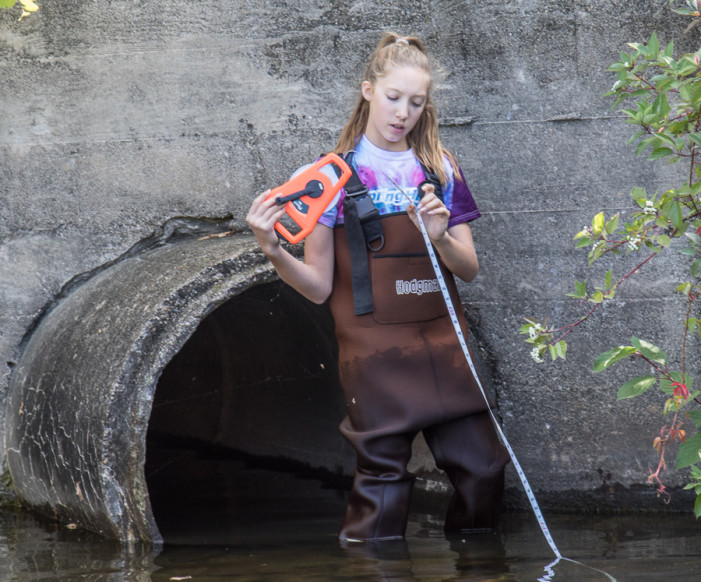By Susan Carroll
Review Writer
Last Friday (Sept. 29), during a sunny fall morning after a slight shower, the eighth-grade science class from Scripps Middle School gathered at the banks of Paint Creek in Children’s Park in preparation of putting their science skills to the test.
The kids’ job for the day was to test the health of the river.
The middle schoolers would be collecting data, analyzing information and processing the results. After spending four hours working through each of the six stations, the kids compiled their data and sent their findings to the Clinton River Watershed Council.
The watershed council supplies data sheets; then the kids do some math and averaging, and come up with a final score that determines the health of the river.
Carol Binggeser, eighth grade science teacher, has been teaching science for 20 years and said that this was the 12th year they have been testing at Children’s Park.
“We used to do it in the spring but switched to the fall to follow the state of Michigan science standards, so it’s better to do the testing in conjunction with the unit we do in the fall than in the spring,” she said.
Binggeser was concerned about the dam being closed for repair because there was no running water. However, now that the dam has been opened, it’s working and functioning and the water is once again flowing. This allowed the class to accurately test the river.
“The lake levels of Lake Orion are still being lowered so the river may have a little more volume'” Binggeser said. Since the dam allows water to go from the bottom in a very controlled manner, the kids were still able to determine how much water is in the river.
“It’s pretty standard every year with the depth being between 1-2 feet. Only if we have a lot of rain and there is a lot of run off do we get more volume,” Binggeser said.
Some of the children donned waders to test the rivers width, depth and velocity to determine the total volume of water flowing through it.
The kids also looked for woody debris, if there was any erosion, the color of the water and if there were any noticeable odors.
At the benthic macroinvertebrates (the bugs) station, muck was scooped out of the river and placed on the shore. The kids picked through the muck and debris with plastic spoons in search of bugs. They then sorted and counted them.
“By identifying the bugs, they (the students) could determine the health of the river. Some bugs tolerate pollution and other bugs don’t. So, if we find bugs that don’t tolerate pollution then that leads us to believe that there is a better health of the stream. However, if we find bugs that do tolerate pollution, it doesn’t mean that the river is polluted,” said Binggeser.
Chemical analysis of the water tested the nitrates, phosphates, dissolved oxygen, pH, turbidity and temperature. Based on those findings, the students fill out a form that gives the health of the river based on the chemical results.
The land use station was set up with maps of Oakland County and Orion Township to see what could be impacting the river right now. Things they were looking for were if there were any current agricultural mining, forestry, residential or commercial developments going on.
The historical data station was set up for creative writing. The students read about the history of Lake Orion and wrote a paper on their findings.
Binggeser shared the students’ results and the overall Health of Paint Creek:
• Overall, Paint Creek received a good health report.
• The chemical tests all came out good to excellent (phosphates, nitrates, turbidity, temperature change and pH), except for low levels of dissolved oxygen.
• The physical survey showed low levels of water flow with high levels of algae and filamentous algae, perhaps from the dam being repaired and the water being stagnant for a few weeks. Wildlife included fish, ducks and crayfish.
• The benthic macroinvertebrates (bugs) found were of the somewhat sensitive group, meaning that they could tolerate some pollution, but that it was not necessarily the case (that the water was polluted).
Students also found some organisms in the sensitive group.
Overall, the macro identification determined the stream was at a fair health level. The dam repair may have impacted the number of species found since it was just reopened the week the students tested the water, Binggeser said.



Leave a Reply